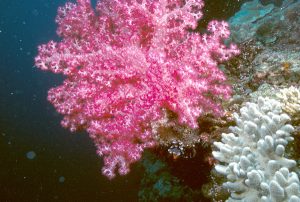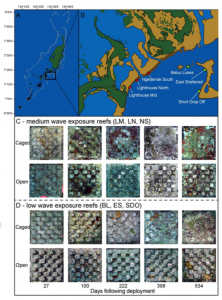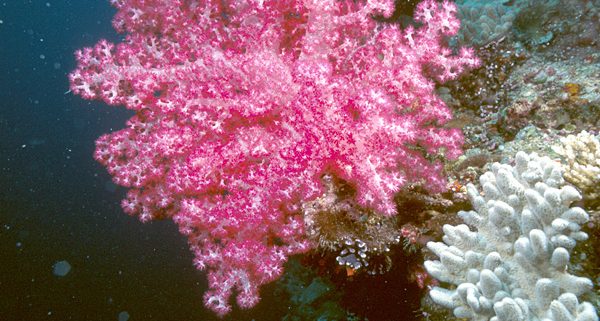Coral Recruitment Shifts due to Sensitivity to Community Succession
By Patricia Albano, SRC intern
Environmental disturbances such as natural disasters, anthropogenic effects, and weather pattern changes have a significant impact on ecosystems. Following such disturbances, communities must adapt and rebuild through succession where they evolve to respond to changes. In this study, researchers Christopher Doropoulous, George Roff, Mart-Simone Visser, and Peter Mumby of the University of Queensland studied the positive and negative interactions that impact community succession in the wake of a disturbance and how these interactions differ along environmental gradients.

Figure 1. Soft Corals Found on Palau Reef
These are examples of the soft corals (Nephtheidae) that inhabit reefs in Palau. These corals are important for the structure and function of the reefs.
Source: Wikimedia Commons
Succession in ecosystems usually follows 2 models: facilitation and inhibition (Connel and Slayter 1977). Facilitating organisms “set the stage” for environmental modifications, making the habitat more accommodating for the later-successional species. Inhibiting organisms are early arrivers that reserve space in the habitat for themselves and prevent the invasion of later-successional species (Connel and Slayter 1977). All species interaction includes two components: negative (competition, predation, inhibition) and positive (facilitation) (Paine1980). These two interaction types allowed the researchers to classify the changes they saw in the coral reef ecosystem study sites. This series of experiments investigates how early succession affects coral reef recovery after 2 subsequent typhoons in the island of Palau in the Western Pacific (Figure1) These 2 typhoons (occurring in December 2012 and November 2013) occurred after no typhoon disturbances for over 70 years. This study site was used to explore how the changes in species interactions after a disturbance affect succession in benthic communities with different environmental gradients and how these successional changes affect coral recruitment and recovery after a disturbance (Doropoulos et al. 2016).
The researchers analyzed the eastern barrier reef of the island that had significantly reduced abundances of juvenile corals. Six sites were chosen within to different wave environments: 3 at reefs with lower wave exposure and 3 at reefs with higher wave exposure (Figure 2). Variables accounted for include: grazing potential of herbivorous fish on available grazeable substrate and percent cover of algae groups in the ecosystems.

Figure 2: Six Reefs of the Study Site in Palau
This map indicates where the 6 reefs used in the study are located along the Palau coastline. The pictures indicate differences in coral recruitment between caged (shielded from herbivorous fish) and uncaged (open to grazing) portions of the reef.
Source: Doropoulous et al. 2016
The researchers found that 3 patterns in environmental drivers influenced the ecosystem. First, a 70% reduction in fish grazing potential was found at the sites that had loss of the majority of live coral cover after the typhoons. Second, shifts in dominance from coral to microalgae occurred at 3 sites with medium wave exposure. Last, microalgae was more abundant in microhabitat crevice areas within both the medium and low wave exposure sites. Coral recruitment was also higher in these crevice areas within the reefs. The researchers came to the conclusion that when herbivorous fish are excluded from reef habitats, a gradual shit towards an algae dominated system occurred at both medium and low wave exposure locations. The results collectively showed that differences in interaction strengths along environmental gradients can lead to changes in the early succession of benthic life that can lead to the inhibition of system recovery after a disturbance such as a typhoon. This experiment revealed important information on how ecosystems recover after disturbances. With this knowledge, nations and conservation organizations can effectively manage their reef ecosystems following a disturbance such as a natural disaster or a weather change. This study also reveals how important it is for healthy reefs to exist in order for ecosystems to continue thriving and support a vast array of life.
Works cited:
Paine, R. T. 1980. Food webs: linkage, interaction strength and community infrastructure. The Journal of Animal Ecology 49: 667-685.
Connell, J. H., and R. O. Slatyer. 1977. Mechanisms of succession in natural communities and their role in community stability and organization. American naturalist:1119- 1144.




Leave a Reply
Want to join the discussion?Feel free to contribute!